ABSTRACT
This study assessed rice farmers’ perception of climate change and adaptation strategies in the Ketu North District, Volta Region of Ghana. Climate variables particularly precipitation and temperature were taken in the climate change perception study. Multistage sampling technique was used to select 340 rice farmers from six farming sections, and a structured questionnaire was used to elicit data from the respondents. Data collected from the rice farmers were analyzed using descriptive statistics and binary logistic regression. Results of the study showed that majority of the rice farmers’ perceived decreasing precipitation and increasing temperature as a major climate variable affecting their agricultural practices. Farmers’ level of adaptation was found with majority of them using irrigation, changing crops, changing planting dates and planting short season varieties. Findings of the study also indicate that the major barriers to climate change adaptation by rice farmers are lack of information about climate change, lack of credits and poor soil fertility. Binary logistic regression analysis found household size, education level, farming experience and financial support as significant predictors. The study concludes that rice farmers in the district perceived changes in climate and employ adaptation strategies to mitigate its effects.
Key words: Binary logistic regression, climate change, socio economics, agriculture.
The agriculture sector is the backbone of the economies of most of the developing world. According to the World Bank report (2011), the sector employs about 60% of the workforce and contributing an average of 30%of Gross Domestic Product (GDP) in Sub-Saharan Africa. However, in recent years the sector is increasingly affected by climate change and change of weather patterns impacting food production, food security, and natural resources. According to Trenberth et al. (2007), many developing countries have already experienced weather events manifested by floods, droughts, heat waves and tropical cyclones that are more frequent or intense than seen in the recent past. Generally, losses in the agriculture sector due to climate change have economy wide consequences, like loss in gross domestic output, a decline in the income/consumption of the most vulnerable population and thereby a general deterioration in households’ welfare (FAO, 2007). Without appropriate responses, climate change is likely to constrain economic development and poverty reduction efforts and exacerbate already pressing difficulties especially in countries whose economies are deep rooted in climate sensitive sectors such as agriculture. Hence knowledge on the perception and adaptation of farmers to climate change and their strategies to deal with the phenomenon is quite crucial.
Adaptation is widely recognized as a vital component of any policy response to climate change. Adaptation to the adverse consequences of climate change could be viewed from two distinct perspectives. First is the awareness of the risks of climate change and the capacity to adapt to climate change, and second is how this adaptation can be carefully planned and implemented to avoid the possibility of mal-adaptation (FAO, 2007). Similarly, Taderera (2010) described adaptation as a way of reducing vulnerability, increasing resilience, moderating the risk of climate impacts on lives and livelihoods and taking advantage of opportunities posed by actual or expected climate change. Perceptions are influenced not only by actual conditions and changes, but are also influenced by other factors. A study by Gbetibouo (2009) found that having fertile soil and access to water for irrigation decrease the likelihood that farmers will perceive climate change. However, in the same study, education, experience, and access to extension services are found to increase the likelihood that farmers perceived climate change. Against this background, this study is aimed to specifically:
(1) Determine rice farmers’ perception of climate variables particularly focusing on precipitation and temperature.
(2) Identify rice farmers’ choice of adaptation measures in response to these climate change variables.
(3) Identify barriers to rice farmers’ adaptation measures in response to changes on these variables, and
(4) Find out the determinants of rice farmers’ adaptation to changes in these climatic variables.
Climate change
The most vulnerable areas or sectors to climate change in Africa are water resources, agriculture, health, ecosystems and biodiversity, forestry and coastal zones. In general, climate change presents a substantial challenge to regional agricultural development. From food security and nutrition to sustainable management of natural resources, climate change is a significant threat to the welfare of millions of the continents rural poor. If adequate measures are not taken to adapt to the adverse consequences of climate change in sub-Sahara Africa, the region will remain vulnerable to the widespread effects of climate change (Food and Agricultural Organization (FAO), 2009). Studies have shown that while agriculture is a primary climate change impact sector, other sectors in the economy are also impacted because of the induced effect from the agriculture sector. For example, Juana et al. (2012) show that 20% reduction in water availability in South Africa due to climate change will lead to a 12% decline in agricultural output. Because of the backward and forward linkages between agriculture and the other sectors of the economy, this 12% decline in agricultural output will lead to about 8% decline in gross sectoral output. Also, this showed that 10% loss in agricultural output in Botswana due to drought will lead to about 8% decline in total sectorial output.
Description of the study area
Ketu North District is one of the 25 districts in the Volta Region of Ghana. It is located between latitudes 6°03’ N and 6°20’ N and longitudes 0°49’E and 1°05’E. It shares boundaries with the Akatsi North District to the North and the Republic of Togo to the East. To the South, it is bounded by Ketu South district and Keta Municipality, and to the west by the Akatsi South District in Figure 1. The district has an estimated population of 100,000, and agriculture is the mainstay of the economy. The target population for the study includes all rice farmers farming at the Weta irrigation scheme within the Ketu North District of the Volta Region of Ghana. The estimated population of rice farmers within the Ketu North District is 1024.
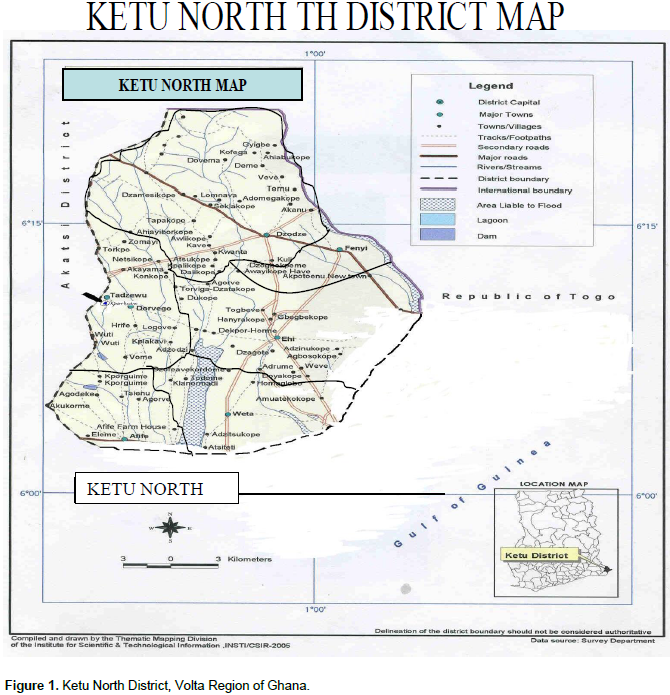
Socio-economic characteristics of the target population
Age of the rice farmers
According to Hofferth (2003), the higher the age of the household head, the more stable the economy of the farm household, because older people have relatively richer experiences of the social and physical environments as well as greater experience of farming activities. Moreover, older household heads are expected to take adaptation strategies than younger heads.
Household size
This is one of the factors expected to have influence adaptation to decreasing precipitation and increasing temperature. The majority of the farm households in the study area are small-scale rice farmers. Because land and finance to purchase agricultural inputs are very limited, increasing family size tends to exert more pressure on consumption than the labor it contributes to production. Thus a positive correlation between household size and adaptation to decreasing precipitation and increasing temperature is expected.
Educational level
Education is an additional factor which is thought to influence the farmer’s adaptation. Educational attainment by the household head could lead to awareness of the possible advantages of modernizing agriculture by means of technological inputs; enable them to read instructions on fertilizer parks and diversification of household incomes which in turn would enhance their adaptation to increasing temperature and decreasing precipitation.
Farm size
Farm size is a continuous variable. This study expected farm size to affect adaptation to increasing temperature and decreasing precipitation positively. According to Najafi (2003), food production can be increased extensively through expansion of areas under cultivation. Therefore, under subsistence agriculture, farm size is expected to play a significant role in influencing rice farmers’ adaptation to increasing temperature and decreasing precipitation. Similarly, a study by Advancing Capacity to Support Climate Change, (ACCCA, 2010), reported that large farm size positively influenced adoption of soil and water conservation, tree planting, and use of improved varieties.
Farming experience
Farming experience is expected to positively influence rice farmers’ adaptation to decreasing precipitation and increasing temperature. Farming experience increases the farmers’ likelihood of adapting climate change strategies. This is due to the fact that the knowledge of the recommendations and application of these strategies is gained over time, with practice. According to a study by Nhemachena and Hassan (2007), Temesegen et al. (2008) and Di Falco et al. (2011), farmers with more years of farming experience are more likely to notice changes in climatic conditions due to their prior experiences.
Financial support
Financial services are recognized as playing multiple roles in development so that improved access can have a far greater and more ample impact on poor households. Access to credit, which also represents the ability to purchase inputs, is expected to positively influence the decision to adopt a climate change. Access to credit increases financial resources of farmers, reduces cash constraints and allows farmers to purchase inputs (Benhin, 2006; Deressa et al., 2009; Gbetibouo, 2009).
Sampling design and sample size
The study used cross-sectional survey design to assess rice farmers’ perception of climate change and adaptation strategies in the study area. Cross-sectional survey design is the appropriate design for the study because data were collected to make inferences about the population of interest at one point in time. A multistage sampling technique was used to select the respondents for the study. The sampling technique was chosen because it allows larger clusters to be subdivided into smaller, more target groupings for the purposes of surveying (Agresti and Finley, 2008). At the first stage, a simple random sampling technique was used to select 6 of the 11 rice farming sections at the Weta rice irrigation scheme in the district. At the second stage, a list of registered farmers of the 6 farming was obtained from the District Agricultural Assembly. Based on the population of these 6 farming sections, a random sampling technique was used to select 340 rice farmers using the sample size table constructed by Krejcie and Morgan (1970). Table 1 provides the summary of farmers selected from the Weta irrigation scheme, Ketu North District, Volta Region, Ghana.

Data collection
The primary data were collected through the use of self-administered questionnaires and interview. The variables were broadly categorized into socio-demographic characteristics, production activities, climate change information, adaptation measures in response to climate change and barriers to adaptation measures. Primary data were collected using open and close ended interview schedules. The questionnaire for the farmers was grouped into 38 items with five sections, I to V. Section I was made up of 12 items that is used to generate information on the socio-demographic characteristics of sampled population. Section II was on the production activities, Section III on climate change information, section IV was on adaptation measures in response to climate change and finally section V was on barriers to adaptation measures. The questionnaires for the primary data collection were pre-tested in South Tongu District. The purpose of the pre-test was to identify errors associated with the questionnaire and interview content, and omit double barreled questions and ambiguous statements. Furthermore, pre-testing was conducted to detect issues that were not anticipated and to assess:
(1) Clarity of questions regarding rice farming
(2) Whether the questions are understandable and
(3) Whether the order and wording of the questions elicited the desired responses for each question.
The total number of questions administered was 15. Based on the responses provided, modifications were made in the research instruments before administration.
Data analysis
To understand the perception and adaptation strategies of the targeted population, we developed a conceptual framework. Social, economic, and institutional factors were taken as variables that can influence farmers’ perception to climate and thereby decide the adaption strategies they implement to overcome the changes in Figure 2. The study also utilized descriptive statistics and logistic regression analysis. SPSS and STATA software were used for all the analysis. Descriptive statistics such as frequencies, mean, standard deviation, and percentages were used to summarize and present rice farmers’ perception on climate change, rice farmers’ decision to adapt to climate change, and the barriers to adaptation. Frequencies and percentages were used to describe farmers’ socio-demographic characteristics; identify farmers’ choice of adaptation measures in response to climate change; and barriers to farmers’ adaptation measures in response to climate change. Descriptive statistics was also used to illustrate the barriers affecting farmers. Logistic regression analysis was employed to analyze the determinants of rice farmers’ adaptation to decreasing precipitation and increasing temperature. Logistic regression is a probability estimation model applied when the dependent variable is binary and the independent variables are in any form of measurement scale (Cramer, 2003). The dependent variable can take the value 1 or 0 depending on the probability of adaptation success or failure in the two variables respectively. The independent variables are the socio-economic characteristics of the rice farmers that include sex, age, household size, educational level, farming experience, farm size, and financial support. The logistic regression model for estimating the probability of adaptation success or failure (Pi) is specified as follows:
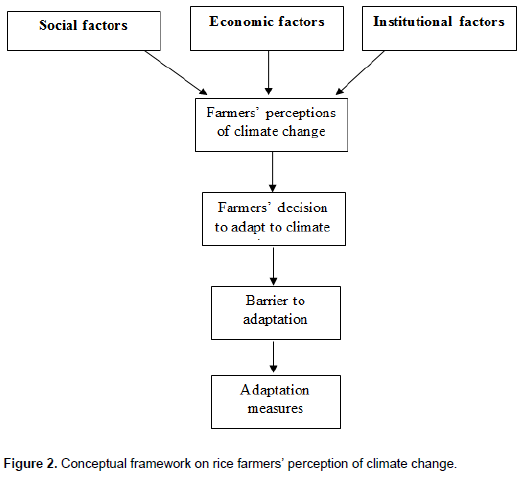
Regression model specification
Probability of adaptation success is given as:
The logit model is a logarithmic transformation of the odds ratio.
Li= ln(Pi/1-Pi)=Zi=a+b1X1+b2X2+…+bkXk+e
Where Li is the log of the odds ratio; e is the base of natural logarithms; a is a constant; X1, X2, …, Xk are explanatory variables; b1 b2,…,bk are estimated parameters corresponding to each explanatory variable; k is number of explanatory variables; and e is the random error.

Rice farmers’ perception of changes in precipitation and temperature
Findings of the study indicate that majority of the rice farmers interviewed perceived changes in climate specifically decreasing precipitation and increasing temperature as shown in Figure 3. This study is consistent with Sofoluwe et al. (2011), who surveyed 100 farmers to gather information on their perceptions about changes in temperature and precipitation in Osun State, Nigeria. Their results showed that majority of the respondents were aware of increase in temperature and decrease in precipitation in the region. Also, Acquah and Onumah (2011) who assessed farmers’ perception and adaptation to climate change in the Western part of Ghana, found that majority of the farmers’ perceived increase in temperature and decrease in precipitation. In a study to analyse farmers’ perception and adaptation strategies to climate change in India, Dhaka et al. (2010), also found that significant numbers of farmers believed temperatures have already increased and the precipitation has declined along with late onset and early withdrawal of monsoon with long dry spells.
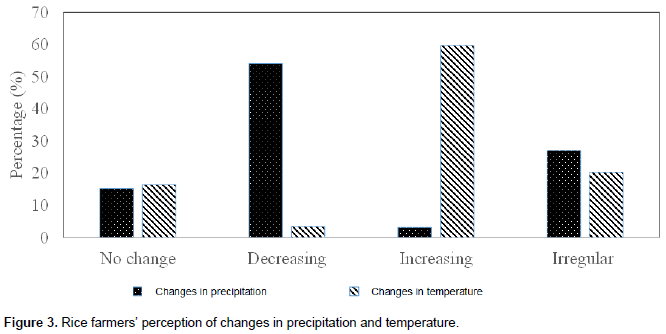
Rice farmers’ choice of adaptation measures in response to changes in precipitation and temperature
In Table 2, finding indicates that rice farmers’ adapted some level of adaptation measures to improve their production such as changing their planting dates, change in crops types, plant short season varieties and irrigation. These findings are consistent with Deressa et al. (2008). These researchers analyzed the determinants of farmers’ choice of adaptation methods in the Nile Basin, Ethiopia. Using cross-sectional data from a survey of farmers to obtain information on adaptation methods, their study found the adaptation methods currently in place in the study area. Accordingly, changing planting dates, using different crop varieties, planting tree crops, irrigation, and soil conservation were the major adaptation methods in the area. From these farmers’ use of different crop varieties was the most common adaptation method, while irrigation was the least common. Also, Fosu-Mensah et al. (2010), investigated how farmers perceive long-term changes in temperature, rainfall and vegetation (91) cover over the past twenty years. The main adaptation strategies reported by the farmers were crop diversification and changing planting dates.
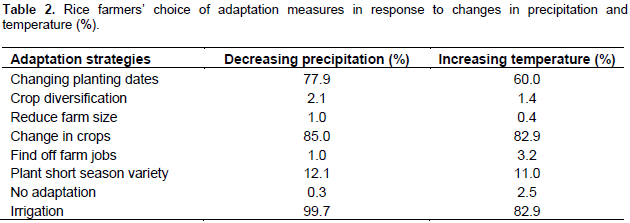
Barriers to rice farmers’ adaptation to climate change
In Table 3, it can be seen that most rice farmers adapted to the changes in climate and faced some barriers in adapting to decreasing precipitation and increasing temperature such as, lack of information about climate change, lack of knowledge about adaptation options, lack of access to credit, no access to irrigation water and poor soil fertility. Findings of the study are also consistent with the study of Acquah and Onumah (2011) who identified lack of information on climate change impacts and adaptation options, lack of knowledge about adaptation measures, lack of access to credit and no access to water as some of the barriers inhibiting the ability of the farmers in Western part of Ghana as the main constraints to adapt to climate change impacts. Also Nhemachena and Hassan (2007), investigated barriers to adaptation, their study indicated that farmers lack of credit facilities, information on adaptation options and insufficient inputs are the main barriers to adopting any climate change adaptation options.
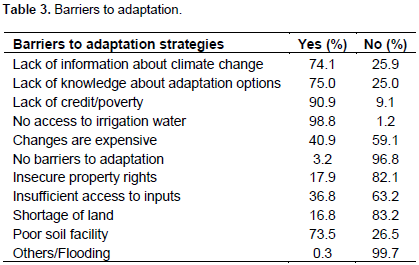
Logistic regression of the determinants of adaptation to decreasing precipitation and increasing temperature
From the results, the Wald chi square value of 65.16 for decreasing precipitation and 98.31 for increasing temperature a p-value 0.000 indicates that the model provides a good fit to the data. Besides, the Hosmer–Lemeshow model fitness test shows also that we cannot reject our model which also means our model fits reasonably well. Based on the results, household size, educational level, farming experience, and financial support were found to be significant predictors to the adaption to decreasing precipitation and increasing temperature in (Tables 4 and 5). An increase in the household size of respondents by one person increases the probability of the respondents adapting to decreasing precipitation by 1.6% and adapting to increasing temperature by 1.5% at 5% significant level holding other variables constant. This finding is consistent with Kandlinkar and Risbey (2000) and Temesegen et al. (2008). They explained that households with more labor are believed to able to take better adaptation measures in response to changes in climatic conditions compared to those with limited labor. In this sense, family size is one important variable that can determine the availability of labor. With respect to education level of respondents, an additional year of education increases the probability of the respondents’ adaptation to decreasing precipitation by 6.5% at 1% significant level, and adapting to increasing temperature by 4.9% at 5% significant level. This finding is consistent with Temesegen et al. (2008).
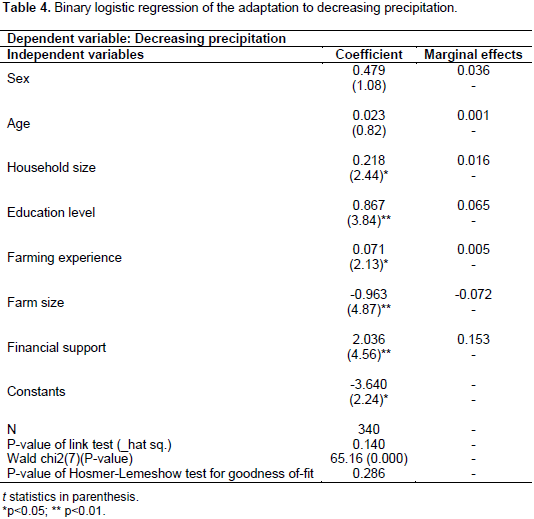
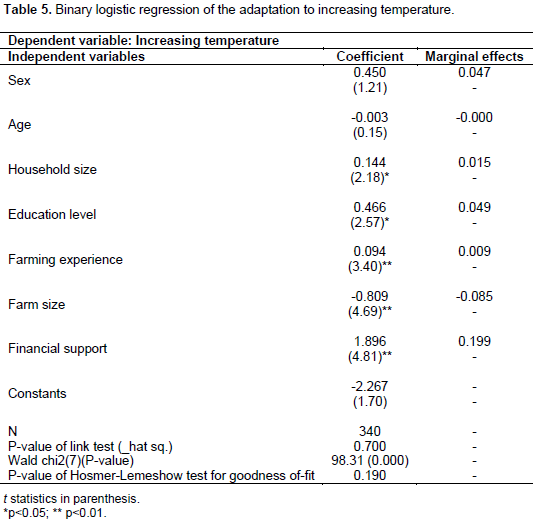
Education is an important source of information for farm level management activities. Farmers with more formal education are believed to be better able to take adaptation measures in response to climate change compared to those without adequate education. An additional year of farming of respondents increases the probability of the respondents adapting to decreasing precipitation by 0.5% at 5% significant level, and adapting to increasing temperature by 0.9% at 1% significant level. This finding is consistent with Nhemachena and Hassan (2007), Temesegen et al. (2008) and Di Falco et al. (2011). They recommended that elder household heads are expected to have more experience in farm practices and management. An additional acre of farm land of respondents reduces the probability of the respondents adapting to decreasing precipitation by 7.2% at 1% significant level, and adapting to increasing temperature by 8.5% at 1% significant level. That is, farmers with smaller farm sizes are likely to adapt to climate change compared to those farmers with larger farm sizes. The study is consistent with Deressa et al. (2009). Independent variables that have demonstrated negative relationship to adaptation such as farm size could be attributed to the fact that adaptation is plot-specific. In other words it is not the size of the farm, but the specific characteristics of the farm that dictate the need for a specific adaptation method to climate change.
In addition, factors identified as affecting the perception of an adaptation to climate change in the study areas are directly related to the development of institutions and infrastructure. Receiving financial support increases the probability of respondents adapting to decreasing precipitation by 15.3% at 1% significant level, and adapting to increasing temperature by 19.9% at 1% significant level as compared to respondents who do not receive any financial support. The findings indicate that farmers who have financial assets to use more fertilizer and labor are more likely to consciously adapt to decreasing precipitation and increasing temperature. Alternatively, farmers with financial support acquire necessary inputs required to adapt to climate change and enhance their production. Such inputs include different seed varieties, fertilizers, and irrigation technologies. The result is consistent with Kandlinkar and Risbey (2000). They suggested that farmers that lack capital and other resources will fail to cover costs necessary to take up adaptation measures, and thus may not make beneficial use of the information they might have.
Climate change and weather patterns have been experiencing negative impacts on food production, food security and natural resources all over the globe. Farmers’ adaption to climate change is crucial to combating food insecurity and related problems. This study sought to empirically understand Rice farmers’ perception of climate change and adaptation strategies in the Ketu North District in the Volta Region of Ghana. Specifically, the study sought to achieve the following objectives:
(1) Analyse farmers’ perception of precipitation and temperature patterns in the study area.
(2) Identify farmers’ choice of adaptation measures in response to climate change;
(3) Investigate the determinants of farmers’ adaptation to change in precipitation and temperature;
(4) Identify barriers to farmers’ adaptation measures in response to climate change;
The summary of the major findings are presented with respect to the objectives of the study; which were as follows:
Rice farmers' perception of changes in precipitation and temperature patterns
Rice farmers in the study area were aware of climate change situation on their production, with majority 84.4% perceived changes in climate as a severe trend whilst 15.6% did not perceived any changes. With respect to precipitation, the study revealed that majority that is 54.1% of the rice farmers perceived a decrease in precipitation; 3.2% perceived an increase in precipitation; 27.4% of the rice farmers perceived an irregular precipitation and 15.3% of the farmers did not see any change in precipitation. Similarly, majority that is 59.7% of the rice farmer’s perceived increases in temperature, 3.5% of the rice farmer’s perceived decrease in temperature, 20.3% of the farmers perceived irregular pattern in temperature and 16.5% of the farmers perceived no change in temperature.
Rice farmers’ choice of adaptation measures in response to climate change
Rice farmers’ in the study area employ some adaptation methods due to decreasing precipitation and increasing temperature. These adaptation measures includes: Irrigation, change in crops, changing planting dates and plant short season variety were identified as the major adaptation strategies used to overcome decreasing precipitation and increasing temperature respectively.
Determinants of rice farmers’ adaptation to decreasing precipitation and increasing temperature
Empirical results from the logistic regression analysis reveals household size, educational level, farming experience and financial supports positively influence rice farmers adaptation to decreasing precipitation while farm size negatively influence adaptation to decreasing precipitation. With respect to increasing temperature, household size, education level, farming experience and financial support positively influence the probability of adaptation to increasing temperature whilst farm size has negatively influence the probability of adaptation to increasing temperature.
Barriers to rice farmers’ adaptations measures
The rice farmers were faced with barriers to their adaptation to climate change. These barriers include: lack of information about climate change, lack of knowledge about adaptation options, lack of credit, no access to irrigation water and poor soil fertility are the major barriers rice farmers’ face in adapting to climate change.
From the findings of the study, the following conclusions are drawn: majority of the rice farmers perceived changes in climate specifically decrease in precipitation and increasing temperature. Rice farmers’ used variety of measures to adapt to decreasing precipitation and increasing temperature. These measures include: irrigation, change in crops, changing planting dates and plant short season variety as the major adaptation measures to climate change impacts. Lack of information about climate change, lack of knowledge on adaptation, lack of credits and poor soil fertility were identified as the major barriers to adaptation. Findings from the logistic regression analysis indicate household size, education level, farming experience, and financial support as significant predictors of the probability to adaptation to decreasing precipitation and increasing temperature respectively.
The authors have not declared any conflict of interests.
REFERENCES
|
Advancing Capacity to Support Climate Change (ACCCA) (2010). Improving decision-making capacity of smallholder farmers in response to climate risk adaptation in three drought-prone districts of Tigray, Northern Ethiopia. Farm level climate-change perception and adaptation in drought prone areas of Tigray, Northern Ethiopia. Project No. 093.
|
|
|
|
Agresti A, Finlay B (2008). Statistical methods for the social sciences (4th ed). Toronto: published by Pearson Education; Prentice Hall. 148pp.
|
|
|
|
|
Acquah HD, Onumah E (2011). Farmers' perceptions and adaptations to climate change: An estimation of willingness to pay. Agris 3(4):31-39.
|
|
|
|
|
Benhin JKA (2006). Climate change and South African agriculture. Discussion paper No. 21 Centre for Environmental Economics and Policy in Africa (CEEPA), University of Pretoria. ISBN 1-920160-01-9.
|
|
|
|
|
Cramer JS (2003). Logit models from economics and other fields. Cambridge: Cambridge University Press.
Crossref
|
|
|
|
|
Di Falco S, Veronesi M, Yesuf M (2011). Does adaptation to climate change provide food security? Micro perspective from Ethiopia. Am. J. Agric. Econ. 93(3):829-846.
Crossref
|
|
|
|
|
Deressa TT, Hassan RM, Ringler C, Alemu T, Yesuf M (2008). Analysis of the determinants of farmers' choice of adaptation methods and perceptions of climate change in the Nile Basin of Ethiopia. Int. Food Policy Res. Institute: Washington, DC.
|
|
|
|
|
Deressa TT, Hassan RM (2009). Economic impact of climate change on crop production in Ethiopia. Evidence from cross-section measures, J. Afr. Econ, 18:529-554.
Crossref
|
|
|
|
|
Dhaka BL, Chayal K, Poonia MK (2010). Analysis of farmers' perception and adaptation strategies to climate change. Libyan Agric. Res. Centre J. Int. 1(6):388-390.
|
|
|
|
|
Food and Agriculture Organization (FAO) (2007). Food and Agricultural Organization Statistical Yearbook, 1 and 2. Rome: FAO Statistics Division.
|
|
|
|
|
Food and Agriculture Organization (FAO) (2009). Climate change in Africa: The threat to agriculture. Retrieved from: fao.org/docrep/fao/012/ak915e/ak915e00.pdf on 25, December.
|
|
|
|
|
Fosu-Mensah BY, Vlek PLG, Manschadi AM (2010). Farmers' perceptions and adaption to climate Change: A Case Study of Sekyedumase District in Ghana, Centre for Development Research, University of Bonn: Bonn.
View
|
|
|
|
|
Gbetibouo G (2009). Understanding farmers' perceptions and adaptations to climate change and variability, the case of the Limpopo Basin, South Africa. IFPRI Discussion paper 00849. IFPRI Research Brief pp. 15-8.
View
|
|
|
|
|
Kandlinkar M, Risbey J (2000). Agricultural impacts of climate change. If adaptation is the answer, what is the question? Clim. Change 45:529-539.
Crossref
|
|
|
|
|
Juana JS, Makepe PM, Mangadi KT (2012). Empirical analysis of the impact of drought on the Botswana economy. Presented at the AERC/UNU-WIDER climate change workshop, Helsinki, September 25-29.
|
|
|
|
|
Krejcie RV, Morgan DW (1970). Determining sample size for research activities. Educ. Psychol. Meas. 30:607-610.
Crossref
|
|
|
|
|
Najafi B (2003). An overview of current land utilization systems and their contribution of agricultural productivity. Report of the APO Seminar on impact of land utilization systems on agricultural productivity. Productivity organization, Islamic Republic of Iran Asia.
|
|
|
|
|
Nhemachena C, Hassan R (2007). Micro-level analysis of farmers' adaptations to climate change in Southern Africa. IFPRI, Environment and Production Technology Division. Washington, DC: Int. Food Policy Res. Institute.
View
|
|
|
|
|
Sofoluwe N, Tijani A, Baruwa O (2011). Farmers' perception and adaptations to climate change in Osun State, Nigeria. Afr. J. Agric. Res. 6(20):4789-4794.
|
|
|
|
|
Taderera D (2010). South African's awareness of climate change. Cape Town, S.A: The Catholic Parliamentary Liason Office. Briefing Paper, 23.
|
|
|
|
|
Temesegen M, Rockstrom J, Savenije HHG, Hoogmoed WB, Alemu D (2008). Determinants of tillage frequency among small holder farmers in two semi-arid areas in Ethiopia. Phys. Chem. Earth Parts A/B/C, 33(1-2):183-191.
Crossref
|
|
|
|
|
Trenberth KE, Trenberth KE, Jones PD, Ambenje P, Bojariu R, Easterling D, Klein TA (2007). The diurnal cycle and its depiction in the Community Climate System Model. J. Climatol. 17:930-995.
|
|
|
|
|
World Bank (2011). Vulnerability, risk reduction, and adaptation to climate change. Washington D. C.
|
|